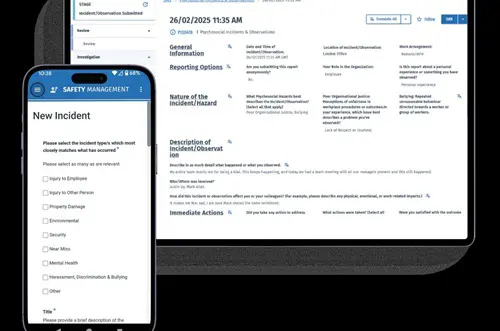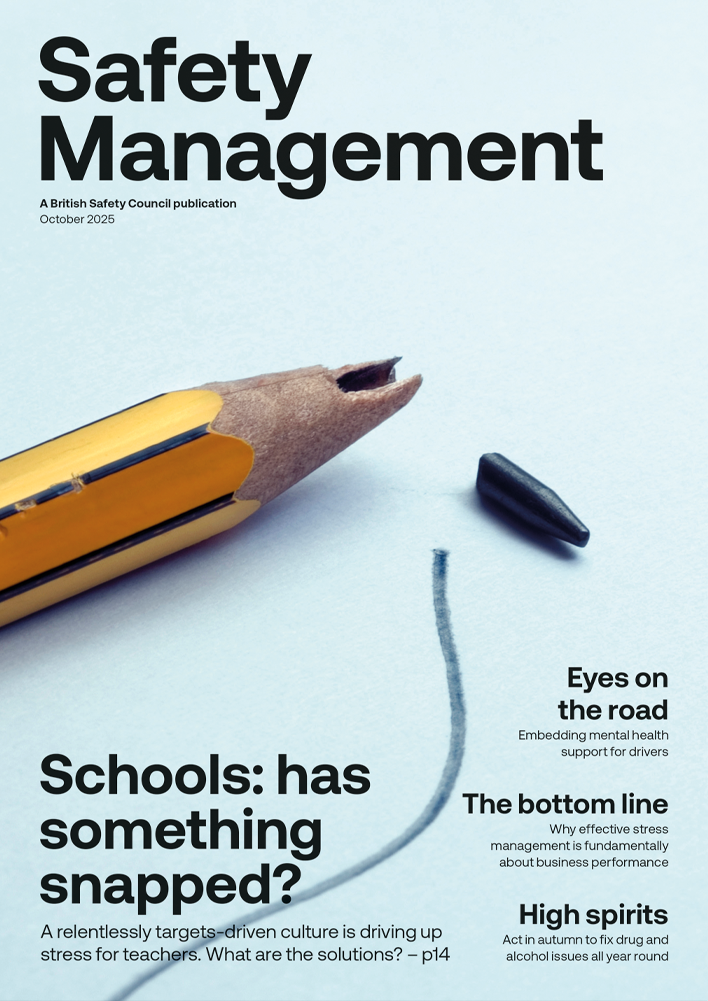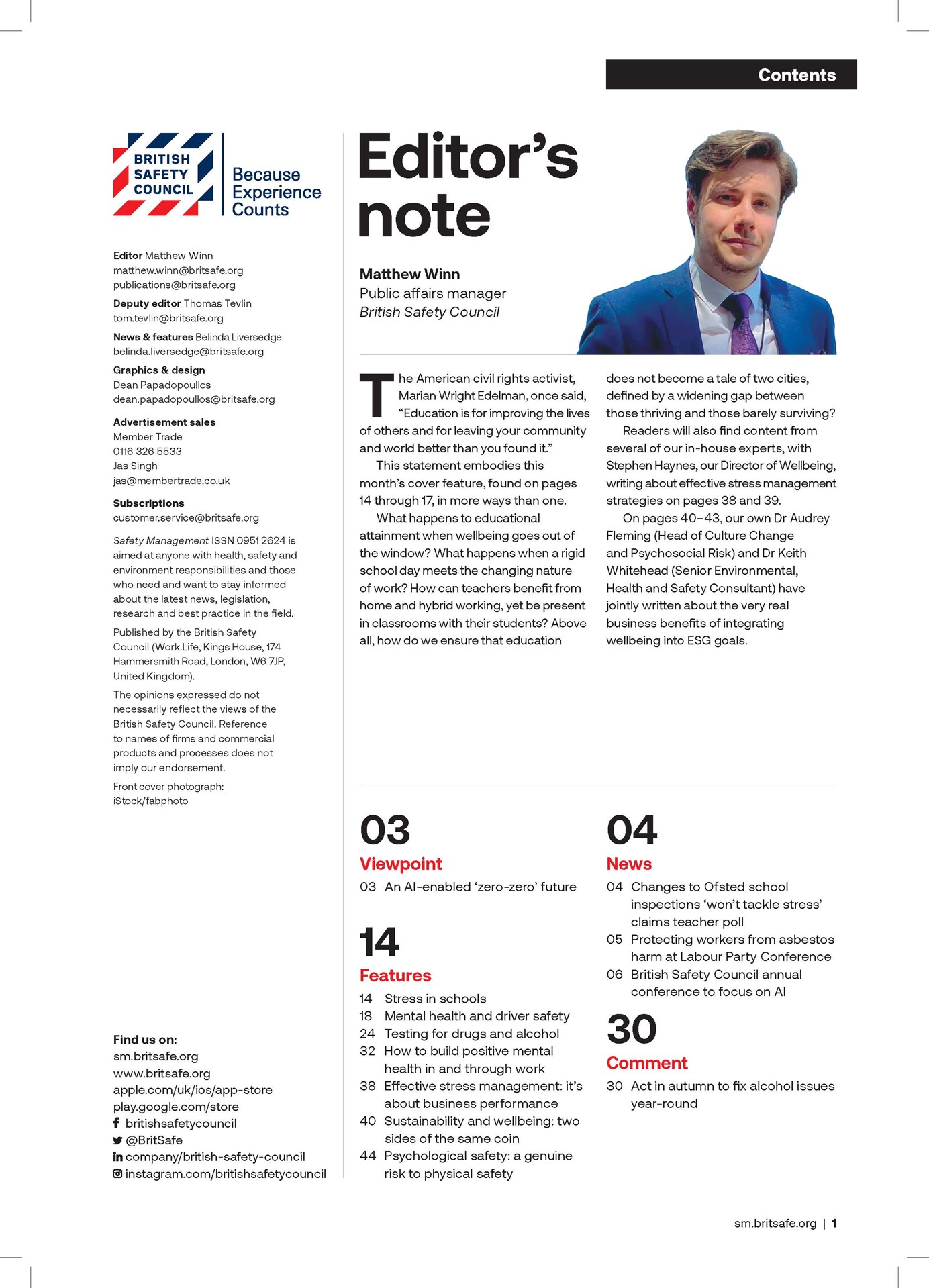Businesses increasingly understand the benefits of integrating their approach to worker wellbeing with their sustainability goals – and there are some practical, low-cost and simple ways of achieving this.
Features
Sustainability and worker wellbeing: two-sides of the same coin
When thinking of sustainability, there is the tendency to think of environmental commitments – for instance, carbon neutrality targets, renewable energy, or responsible supply chains. However, these only tell part of the story. True sustainability is not only about protecting the planet, but also about organisations thriving and remaining resilient; which requires protecting the wellbeing of their people.
If we consider the three ‘Ps’ of the triple bottom line (profit, planet, people), when businesses commit to measuring their social and environmental impact, the ‘people’ element often receives the least attention; yet this is the foundation of the other two. If a workforce is stressed, disengaged or burned out they cannot deliver sustainable performance. Research increasingly shows that a workforce that feels valued, supported and psychologically safe becomes the driver of resilience and innovation in a business.
The interlinkage between sustainability and wellbeing is now recognised as a practical business consideration. This is because:
- Healthy people sustain healthy businesses – employee wellbeing directly influences productivity, safety performance and retention rates.
- Psychosocial risks are business risks – unmanaged workloads, lack of autonomy or toxic cultures erode wellbeing and, over time, undermine organisational resilience.
- Sustainable environments support thriving employees – organisations that design work responsibly, setting realistic demands, encouraging flexibility, and embedding fairness, create conditions where wellbeing and sustainable performance reinforce one another.
To be achievable, both sustainability and wellbeing require authentic leadership that looks beyond short-term wins and towards long-term strategy. Whether it be ESG (Environmental, Social and Governance) disclosures or psychosocial risk legislation, organisations are being asked to demonstrate how they protect the environment and how they protect people. This also provides reputational advantages as investors, customers and future talent demand these commitments.
 To be achievable, both sustainability and wellbeing require authentic leadership. Image: iStock
To be achievable, both sustainability and wellbeing require authentic leadership. Image: iStock
Embedding wellbeing into sustainability strategies should be considered an investment
that will lead to long-term business success and not simply viewed as a costly exercise.
Making the connection
For some organisations, integrating worker wellbeing into sustainability can appear to be an overwhelming process and task – however, there are some frameworks and approaches that can be implemented.
Environmental, Social and Governance (ESG) framework
Many organisations now understand that employee wellbeing is a critical part of their overall business approach to sustainability and that worker wellbeing is clearly linked to the ESG frameworks that are used to reflect a company’s sustainability and ethical impact on employees, wider society and the environment. From a wellbeing perspective, the ‘Social’ pillar of ESG assesses how an organisation treats its employees, customers, suppliers and communities, including its approach to issues such as diversity, inclusion, equity, human rights, health and safety and employee wellbeing.
United Nations’ Sustainable Development Goals and the Global Reporting Initiative
The UN 2030 Agenda for Sustainable Development with its 17 Sustainable Development Goals (SDGs), 169 targets, and 231 unique indicators shapes the direction of global and national development policies, and offers new entry points and opportunities for bridging the divide between human rights and development. It serves as the overall framework to guide global and national development action.
The Global Reporting Initiative (GRI) Standards are the most widely used standards for reporting ESG performance and over 10,000 organisations across more than 100 countries currently use the GRI Standards for their sustainability reporting, which includes both environmental and wellbeing indicators. GRI has several standards that can help companies understand and disclose their impacts on health and wellbeing.
The GRI now represents the main international standard for sustainability/ESG reporting and provides a fundamental framework for companies across all sectors to follow the definitions of key topics, indicators and metrics to be disclosed in sustainability reporting – including those related to employee health and wellbeing.
The GRI requires organisations to carry out a so-called ‘materiality assessment’ to determine ‘material topics’, which are defined as ‘the topics that represent the organisation’s most significant impacts on the economy, environment, and people, including impacts on their wellbeing’.
An assessment on wellbeing involves identifying and prioritising how a company’s actions affect employee and societal wellbeing, as well as how wellbeing trends financially impact the company itself. This approach is a key part of an ESG strategy, especially under the framework of ‘double materiality’.
Therefore, when health or wellbeing are considered to be ‘material topics’ following a company’s materiality assessment, the company is expected to disclose the connected indicators, in line with the GRI sustainability reporting standards.
The GRI 403 Occupational Health and Safety Standard sets out global best practice on reporting about occupational health and safety management systems, prevention of harm and promotion of health at work, and is therefore highly relevant when businesses are reporting their health and wellbeing impacts and performance. GRI 403 has also had a major impact on workplace measurements of – and reporting of – work-related injuries.
A practical example is the materiality assessment that Marks & Spencer conducted when reporting its sustainability performance in line with the GRI Standards, which identified the social impact of M&S colleague wellbeing. This contributed towards the company developing bespoke mental health training and support for staff, including a dedicated health and wellbeing network for colleagues. The company also focused on product health and wellbeing, including offering food products with responsible nutritional content and which met government health targets; and community engagement, including engaging with customers and communities through various projects.
 'Measure and analyse'. Photograph: iStock
'Measure and analyse'. Photograph: iStock
The GRI and United Nations Global Compact (UNGC) have released a Practical Guide on integrating the Sustainable Development Goals (SDGs) into corporate reporting. This guide is designed to help companies of all sizes to prioritise their SDG targets, take action and report on progress.
The UNGC guide outlines a three-step process to embed SDGs into existing business and reporting processes. The guide highlights that the recent GRI publication, Business Reporting on the SDGs: An Analysis of the Goals and Targets, should also be used as part of a company’s regular reporting cycle. The three steps, outlined for companies, in the guide are as follows:
- Define priority SDG targets – including understanding the SDGs and their associated targets, conducting principled prioritisation of SDG targets and defining SDG-related report content. This step is focused on determining which SDG targets should be prioritised based on an assessment of risks and benefits to employees, people and the environment.
- Measure and analyse – including setting business objectives, selecting appropriate disclosures and collecting and analysing data. The purpose of this step is to identify and align objectives and strategies to contribute to priority SDG targets.
- Report, integrate and implement change – including consideration of good practice reporting, consideration of data users’ information needs and reporting and implementing change. This step is focused on setting out what is needed for putting together the content of the external report and reflecting internally on implementing change.
The United Nations SDGs and wellbeing
Workplace wellbeing is central to the UN’s SDGs, with SDG 3 explicitly aiming to “ensure healthy lives and promote wellbeing for all at all ages”. However, health and wellbeing are also intrinsically linked to almost all the other 16 UN SDGs, as factors like Gender Equality (SDG 5), Decent Work and Economic Growth (SDG 8), Education (SDG 4) and Climate Change (SDG 13) all significantly impact quality of life and employee wellbeing.
Wellbeing is a golden thread that connects nearly every one of these goals but in terms of employee wellbeing some examples of the links include:
SDG 1: No Poverty Decent living wages and economic security reduces stress and improves quality of life.
SDG 2: Zero Hunger Nutrition is foundational to physical and cognitive health
SDG 4: Quality Education Education empowers individuals and improves mental wellbeing.
SDG 5: Gender Equality Reduces employment discrimination and inequality due to gender, improving emotional and social wellbeing.
SDG 6: Clean Water and Sanitation Prevents disease and supports dignity.
SDG 8: Decent Work and Economic Growth Meaningful employment boosts self-worth and stability.
SDG 11: Sustainable Cities and Communities Safe, inclusive spaces foster community and individual wellbeing.
SDG 13: Climate Action A stable climate protects health, livelihoods and wellbeing.
A healthy planet supports healthy people therefore factors such as climate change, pollution and biodiversity loss directly impact physical health and mental wellbeing, especially among vulnerable populations.
To further demonstrate the link between sustainability and wellbeing, let’s consider the UN SDGs related to Climate Action and Environmental Protection (UN SDGs 13–15) as an example. Viewing the climate crisis through a ‘wellbeing lens’ highlights how environmental degradation (the deterioration of the natural environment, caused by human activities or natural processes, through the depletion of resources, destruction of ecosystems, and pollution) severely harms mental and physical health, leading to mental health issues such as anxiety, depression and direct trauma from extreme weather impacts.
It also results in further deterioration in chronic health conditions affecting the population due to poor air quality. This perspective reframes the climate crisis as a health and wellbeing emergency, and this includes employee wellbeing.
 A healthy planet supports healthy people. Photograph: iStock
A healthy planet supports healthy people. Photograph: iStock
ISO standards
The ISO (International Organization for Standardization) has many standards that help organisations to contribute to and align with the UN SDGs.
While the ISO 14001 Environmental Management Systems Standard does not explicitly address workplace wellbeing, this standard can indirectly contribute towards improvements in this area by ensuring that businesses operating in alignment with the standard’s requirements (and achieving certification under it) create a sustainable and responsible culture that prioritises employee health, engagement and trust. This can be achieved by:
- Fostering a positive work environment: by promoting environmental responsibility, improving overall company morale and a sense of purpose among employees who want to work for sustainable organisations.
- Enhancing engagement and focus: employees feel more engaged when they are part of an effort to make a difference, which can increase their focus and reduces employee turnover.
- Supporting financial benefits for wellbeing: the standard’s focus on resource efficiency and cost savings (for example, reduced energy, water and waste) can free up capital that can be reinvested into employee wellbeing.
- Building trust and reputation: demonstrating a commitment to sustainability through ISO 14001 enhances the organisation’s reputation, which can extend to its relationships with employees who value working for responsible companies.
ISO 45003 Occupational Health and Safety Management – Psychological Health and Safety at Work Standard is a supplementary standard to the ISO 45001 Occupational Health and Safety Management Systems Standard, and provides practical guidance to help organisations manage psychosocial risks and promote employee wellbeing. Although ISO 45003 is not a standard that directly relates to environmental sustainability, a focus on employee wellbeing contributes to a more sustainable, resilient and ethical organisation overall. This is due to the following factors:
- Long-term viability: prioritising employee wellbeing helps create a more stable and productive workforce, contributing towards the long-term success and resilience of an organisation.
- Ethical responsibility: implementing the standard demonstrates a commitment to ethical obligations and responsible management practices, which are key aspects of overall organisational sustainability.
- Integrated approach: by incorporating wellbeing into the health and safety management system, organisations can take a more holistic approach, linking human capital to overall business sustainability.
 Employees feel more engaged when they are part of an effort to make a difference. Image: iStock
Employees feel more engaged when they are part of an effort to make a difference. Image: iStock
The ISO 26000 guidance on social responsibility by businesses is considered an overarching voluntary framework which help influence and direct the contribution businesses make to sustainable development. It provides guidance on how businesses can operate in an ethical and transparent way, taking into account the expectations of stakeholders, applicable laws and international norms of behaviour. An organisation’s level of social responsibility influences everything from its reputation to its ability to attract top-talent employees and its relationship with suppliers, clients and the communities in which it operates.
This contributes to organisational sustainability and wellbeing by helping businesses:
- Understand how they currently impact society and contribute to sustainable development.
- Identify, engage and respect their relevant stakeholder expectations.
- Define which issues are relevant and significant and ensure they are prioritised for action.
- Ensure compliance with applicable laws and ensure consistency with with international norms of behaviour.
- Integrate responsible behaviour throughout their organisation and relationships.
The future of sustainability is people-centred
The conversation about sustainability is evolving. Thriving organisations are those who understand sustainability is not only about protecting the environment but also about building workplaces where people can flourish.
Workplace wellbeing is not a ‘nice to have’, nor an initiative that sits apart from strategy, it is the measure of whether an organisation is truly sustainable.
If we want organisations that can withstand disruption, contribute positively to society and deliver long-term value, then we must see worker wellbeing and sustainability for what they are: two sides of the same coin.
How can British Safety Council support your organisation?
British Safety Council can support your organisations to merge wellbeing and sustainability through our suite of Five Star and ISO audits, associated Occupational Health and Safety, Environmental and Wellbeing consultancy and training programmes. This includes:
Assessment and gap analysis
- Gap analysis for wellbeing, psychosocial risks and sustainability
- Assessment tools, surveys, focus groups
- Reviewing ESG and Environmental Management strategy, policies and systems.
- Mapping the integration between wellbeing outcomes and sustainability goals.
Leadership engagement
- Workshops linking authentic leadership, wellbeing and sustainability.
- Workshops/coaching to build leadership capability to recognise psychosocial risks and champion sustainable work design.
Embedding strategy and culture change
- Culture change assessment and interventions.
- Review of policies and strategies.
Five Star Environmental Sustainability, Five Star Wellbeing and Five Star Occupational Health and Safety Audits
- Our international renowned five-star audits interlink environmental sustainability and wellbeing alongside Occupational Health and Safety and provide an assessment and roadmap to best practice.
Training and education
- A comprehensive suite of training and qualifications in Occupational Health and Safety, Wellbeing and Environmental Management, through our Digital Learning, face-to-face classroom or virtual classroom platforms.
Dr Audrey Fleming is head of culture change and psychosocial risk and Dr Keith Whitehead is senior environmental, health and safety consultant at British Safety Council. For more information see: britsafe.org
FEATURES

The psychosocial safety challenge: why UK organisations must rethink risk management
By Jose Arcilla, HSI on 09 December 2025
Employers are increasingly keen to effectively manage psychosocial risks such as stress, bullying and poor work-life balance, and EHSQ digital tools make it easier both for workers to report psychosocial problems and for managers to spot patterns and trends, intervening early to protect everyone’s mental and physical wellbeing.

AI-powered wearables: transforming workplace health and safety
By Graham Sharp, Stanley on 08 December 2025
Wearable technology powered by AI analysis is now regularly deployed to prevent safety problems like musculoskeletal injuries and collisions between forklifts and pedestrians, and future developments mean the technology looks set to make it easier to manage other safety challenges, like site evacuations.

Supporting neurodiverse employees: why standard DSE assessments fall short
By Guy Osmond and Alex Reffell, Osmond Ergonomics & Wellbeing on 08 December 2025
Display screen equipment assessments have traditionally focused on tackling the physical ergonomics of desk-based work in a bid to reduce musculoskeletal risks, but effectively supporting the wellbeing and productivity of neurodivergent workers involves a wider consideration of their cognitive, sensory, organisational and environmental needs.



